Rolf Potts's Blog, page 105
March 3, 2012
Special March 2012 fares for multi-stop tickets on BootsnAll
Vagablogging :: Rolf Potts Vagabonding Blog
Long-term travel is something that many Americans just assume is impossible to do. While taking a long trip, whether it's a traditional RTW trip or just simply traveling for more than a few weeks at a time, is certainly not easy, there are plenty of ways to make it possible.
One of the ways to make long-term travel a reality is to spend money wisely and travel on a budget. Budget travel means many things to many people, but it doesn't necessarily have to mean staying in grubby 16-person dorm rooms and eating Ramen noodles for all your meals. There is a difference between being a cheap traveler vs. being a budget traveler.
There are plenty of tips to employ when traveling on a budget. A recent article on BootsnAll highlighted a family who traveled by bike around Europe for $14 per person per day. That's certainly one creative way to do it. But you don't have to go to extremes to be able to travel the world. Start small – travel in shoulder season or take advantage of free attractions to help offset the high costs of plane tickets and accommodations.
While traveling for several months or even a year takes some sacrifice, with a little ingenuity most anyone can make it happen. It's all about making travel a priority in your life, no different than saving for a house or a nice car. Once you make it your top priority, it can happen. What are your favorite budget travel tips that can keep you going for longer?
If you do decide to throw caution to the wind and travel the world, the first thing you'll want to look at is airfare. Your options are many, but be sure to keep your eye on different deals around the web. BootsnAll has monthly deals that can take you all over the world, so be sure to check out the following deals, which are good through March 31, 2012:
RTW Sample -New York – Beijing – Hong Kong – Singapore – Bangkok – Saigon / Ho Chi Minh City – Paris – OVERLAND – London – Reykjavik – New York from $2498 plus taxes.
Hoofing It Around the World – New York – Bogota – OVERLAND – Sao Paulo – Johannesburg – OVERLAND – Nairobi – Istanbul – OVERLAND – Athens – Cairo – Dubai – OVERLAND – Muscat – Cochin / Kochi – OVERLAND – Calcutta / Kolkata – Bangkok – OVERLAND – Singapore – Yogyakarta – OVERLAND – Bali (Denpasar) – Hong Kong – OVERLAND – Beijing – New York from $3873 plus taxes.
Canuck's Classic RTW – Vancouver – Beijing – Delhi – OVERLAND – Bombay / Mumbai – London – Rome – OVERLAND – Paris – Vancouver from $2525 plus taxes.
If you are looking for something a little different in your round the world trip, then start planning your trip of a lifetime with our RTW trip planner And don't forget to sign up for BootsnAll's RTW newsletter, delivering special deals, RTW trip planning advice, and resources via email every single month. We also have a Facebook fan page and Twitter page, so be sure to like and follow those to keep up to date on all your RTW travel needs.
Original article can be found here: Special March 2012 fares for multi-stop tickets on BootsnAll
March 2, 2012
Pre-trip planning, post #2: travel insurance
Vagablogging :: Rolf Potts Vagabonding Blog
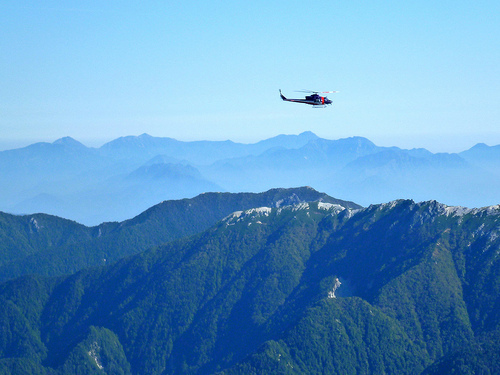
Photo by Rick McCharles
This post is the second in a series on pre-trip planning (see the Intro and post #1: research).
When it comes to travel insurance, people play their own game. Some risk it and just pay medical fees abroad (should they incur any), while others purchase a travel insurance plan before departure.
Since I live in a country (Israel) that provides national health insurance, when I go on non-risky trips–like Eastern or Western Europe–I usually purchase national travel insurance, which works out to a dollar or two a day and covers basic medical expenses (though there is a co-pay) and emergencies. On my current trip, which is chock full of snowboarding, skiing, mountain biking, and trekking, I looked into getting more comprehensive insurance that covers adventurous activities. World Nomads was recommended to me, and I found their website clear and easy to navigate. I purchased their "Explorer" insurance, which covered all the activities above, and worked out to $172 for 6 weeks. Importantly, they cover medical evacuation, which is a concern among trekkers–if you get altitude sickness or are otherwise ill and have to be airlifted out of a remote region via helicopter, you're looking at $5-6,000 in helicopter fees.
Other options for trekkers and climbers include purchasing a membership with the American Alpine Club or the British Mountaineering Council.
Lastly, it's important to purchase insurance before you hit the road, as lots of places won't insure you once your trip starts. It's generally no problem to extend your insurance plan if you decide to extend your travel plans.
Which insurance plans have you used?
Original article can be found here: Pre-trip planning, post #2: travel insurance
Is it cheaper to travel than live at home?
Vagablogging :: Rolf Potts Vagabonding Blog
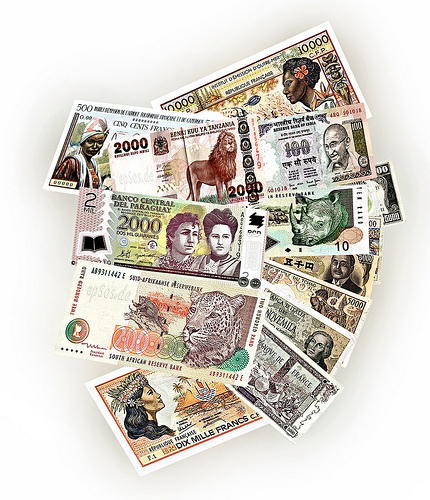
International currency. Photo: epSos.de / Flickr
A common lament I hear is, "I'd love to travel. But it's just too expensive." How much money do you really need to travel year-round? Would you need $50,000 year? Maybe $100,000?
Nora Dunn from The Professional Hobo answered that question in her classic article: Travel full-time for less than $14,000. In many first-world cities, that money wouldn't even cover the rent for a small apartment. Or even pay for university tuition in the United States.
She does a deep dive into all the costs of vagabonding. Along the way, Nora reveals all of her tricks and strategies. The great part is that the story isn't just about getting more from your money; it's about getting as much personal growth from your journey as possible. She talks of volunteering and participating actively in the communities she enters, and how that changed her.
Naturally, there are some big upfront assumptions. You've gotten rid of your house and car, as well as eliminating most of your debt. Still, it's practical inspiration.
Do you find travel cheaper than living at home? Please share your experiences and budgets.
Original article can be found here: Is it cheaper to travel than live at home?
March 1, 2012
Possessed by guidebooks: how to exorcise yourself
Vagablogging :: Rolf Potts Vagabonding Blog
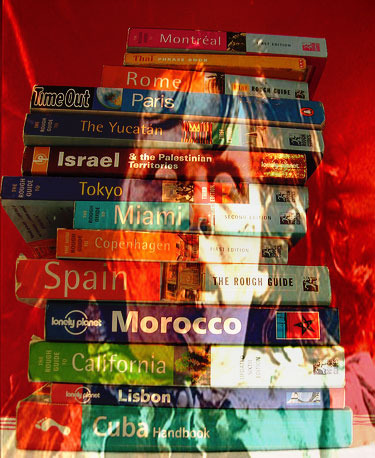 Travel scientists have unearthed that a human subspecies called backpacker, or traveller, has been observed across many of the furthest flung corners of the globe reading guidebooks more than interacting with locals.
Travel scientists have unearthed that a human subspecies called backpacker, or traveller, has been observed across many of the furthest flung corners of the globe reading guidebooks more than interacting with locals.
"So do you want to come with me for breakfast?"
"Sure! "
"Any preferences? I saw a street stall at the corner selling what looks like an awesome fruit salad"
"Well… actually, if you look here at page 267, the guidebook mentions this place… I'm sorry, we have to eat there"
"Why?"
"Well… because it's in the guidebook!!"
If there was a Travel Exorcist, dear guidebook, its power would compel you; because you can be the reason why such a conversation has become a standard among travel circles. I am sure that, whether you are born a Lonely Planet, Rough Guide, Footprints, Moon, Bradt or any other, you and the authors and editors who put your attractive paragraphs together are not the only ones to blame.
I think it is mainly because of the authoritative halo you emanate: with a country's name printed boldly across your front cover, you are a dangerous spell. You can possess people who think they are travelling freely, and instead follow your suggestions blindly, fearing an almost certain death when going out of your carefully prepared itineraries and suggestions. Some even eat only in those restaurants which you recommend!!! Dear guidebook… what have you done to travelling?
Obviously, this is not a stereotype: many travellers say that "if it's in the book, I do not go there". Sometimes, the guidebook spell creates an inverse, mesmerizing process of discovery.
Personally, I like to have a guidebook with me to thumb trough when I am in those interminable bus rides, to use as a quick reference and a place to start looking for cheaper accommodation options when lacking internet connectivity on the road. I have a few suggestions to give the Vagabonders out there, in order to exorcise you from the evil powers of guidebooks:
Be your own master
There is no written rule you have to follow without thinking with your own brain. Sure, many suggested places are actually in the book because they really are must-see destinations. However, this does not mean that your experience has to be totally crafted after a book's index.
Use other people's experience for your own good
A guidebook is intended to "guide" you through an experience, which is ultimately your own. Do not rely too much on hotel and restaurant suggestions, because most of the times guidebook authors do not even sleep in the place for one single night. Use sites such as www.hostelworld.com to have a recent idea of prices and customer reviews, or just put your backpack in a cloak room, get to your area of choice, and do walk-ins.
Travel is time sensitive
Research for a guidebook has been generally done at least one year prior to publication, and although destinations do not change, prices and standards do, a lot. Therefore, take everything with a grain of salt, and do not rely on guidebooks' information as it was the Holy Bible. I have used 10 year old guides to conduct awesome trips. Brian Thacker travelled on a 35 years old Lonely Planet's Southeast Asia on a Shoestring, and even wrote a book on that trip!!
Do not fear the reaper
Citing Blue Oyster Cult, I want to remember you that you will not get lost, die, or get shot if you do not follow a guidebook thoroughly. Most of the times, the best travel experience come when you leave the book in your hotel room, and you wander the streets, randomly. I may also add that, by walking around holding a guidebook, you look totally uncool!! And the touts will love you so much you will damn yourself at the end of the day… such an easy target!
Do you agree with me, or are you already hunting down the next restaurant mentioned at page 47?
Original article can be found here: Possessed by guidebooks: how to exorcise yourself
Be a tour guide to fund your travels
Vagablogging :: Rolf Potts Vagabonding Blog
Let's face it. There's no use fighting the tourist industry. It's exponential. My advice is to embrace it!
Many people ask me how I've funded my travels for so many years. The answer; I've been: a tour guide; paid to be outdoors, able to ride my own horses; and gain knowledge of an area by teaching about plants, animals, geology and history. The key to being a good tour guide is conveying information in a meaningful way. Sure, it is hard work. During the height of the season you'll work long hours. However, being a seasonal guide gives you the opportunity to move to different locations every three to four months, make contacts, experience amazing places, as well as gain different skills. Depending on the companies, many are willing to train seasonal staff. For example, I love dogs but knew nothing about mushing Sled Dogs. Therefor I got a job as a Dog Sled Guide and learned about mushing while taking people out on tours. The company provided room, board and for the most part I used my tips as daily spending money and saved my other pay for traveling between seasons. Altogether I'd work only eight or ten months of the year and use the remainder to explore, travel or relax.
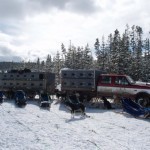
Trail office of Spirit of the North Dog Sled Adventures

Dogs ready to go on tour in Moonlight Basin, Montana
Pick an area where you'd like to go and a skill you're good at or would like to learn.
For instance, if you love water, you could be a raft guide in Idaho or New Zealand or a whale watching guide in Alaska.
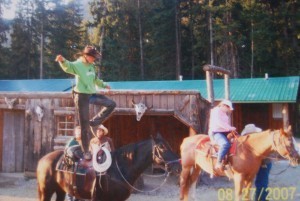
Working as a wrangler at Mountain Sky Guest Ranch, Montana
Right now the seasons are changing. These changes mean places are now hiring. If being a guide interests you; now is the time to start searching for opportunities.
Have you ever worked as a tour guide to fund your travels?
Original article can be found here: Be a tour guide to fund your travels
February 28, 2012
Taking travel home with you: buying souvenirs abroad
Vagablogging :: Rolf Potts Vagabonding Blog

Sapa, Vietnam
Vagabond travel is about the experience. It's less focused on the "stuff" you bring and buy, and more about the freedoms as an open minded traveler with a light backpack. Rolf shows us the pros of traveling stuff-less in his Round The World challenge trip, but if you know what you're looking for and have some extra space, souvenir hunting abroad can lead to some extraordinary experiences.I'm not talking about toting Portuguese ceramics around Europe or filling your backpack with I Love (insert city name) t-shirts at every stop. I'm talking about small pieces that will always remind you of your time away from home. In many places, you can get a beautiful local print for less than what a mass produced picture would cost at a Linens 'N Things.
Here are some rules I like to live by on the road:
1.) Even if you don't buy, interacting with shopkeepers is a great way to glimpse into local life. Window shopping is free, and can lead to some hysterical experiences, seen here as Rolf explores a market in Morocco on his No Baggage Challenge.
2.) Research what kinds of things your destination has to offer. Know the price range for a Nepali cashmere scarf before hitting the streets, and also look into potential scams. Bangkok is known for luring tourists to faux gem stores, charging customers competitive prices for lookalike gems.
3.) Analyze the quality of the item in question. Not only do most local vendors not have return policies, but you'll likely be onto a new city or even home before you notice it's cheaply made or broken.
Kathmandu storefront
4.) Look for fair trade shops when purchasing handicrafts, which ensure that the artists earn fair wages and work in good conditions. Friends International shop in Phnom Penh is one of my favorite examples.
5.) Watch out for breakables…If you're browsing the Czech glass shops of Prague, don't stand too close…If you break, you buy.
6.) It's fun to say "I got this in Laos!" But make sure you're buying for the right reasons. Do you love what you see? Is it unique to the region? Is it something that's truly worth carrying in a backpack until you return home?
If room in my backpack permits, here are my favorite things to look for abroad:
Postcards and stationary: These are great reminders of world travel, and can also be shared with others! Each postcard or letter sent means less "stuff" in your backpack.
Handcrafted jewelry: I look for something that is unique, wearable and won't break the bank. One of my favorite things is a small silver bracelet from the Black Hmong woman who walked with me for 5 hours while trekking in Sapa, Vietnam.
Handwoven crafts: Travels in South America and Southeast Asia have brought me to incredible villages where handwoven products often take weeks to make and cost less than 10 dollars.
Artwork: most small prints can lay flat in a suitcase or fit between a book, and can then be framed at home.
What do you think? Have you fallen into the tourist trap of useless "stuff?" Where have you gotten your favorite souvenirs? Do you have any tips for other travelers who are interested in picking up a souvenir or two?
Original article can be found here: Taking travel home with you: buying souvenirs abroad
Is the kitchen sink necessary for traveling with a baby?
Vagablogging :: Rolf Potts Vagabonding Blog
I'm about ready to scream. Seriously.
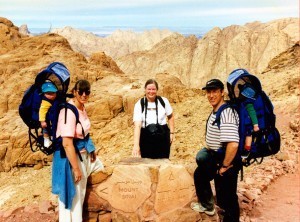
Climbing Mt. Sinai with babies
I've been reading way too many articles lately about traveling with babies and each and every one lists an enormous pile of gear one "must" have for successful travel with little ones. It's driving me crazy.
I am very grateful that we lived overseas when our twins were born. We were surrounded by expats and every expat family we knew traveled extensively with their children and nobody ever questioned it. It was simply a part of life and there was no hype or hysteria about it. We traveled. It's what we did.
We didn't travel with portable playpens or tents for the boys to sleep in. We didn't stress over strollers and car seats or fancy toys to keep the kids occupied on the airplane. And no – we didn't haul a childproofing kit stuffed full of doorknob covers, plastic outlet covers, and pipe cleaners or twisties to secure drapery and electrical cords either. We just traveled. A lot. And we watched our kids carefully.
We carried diapers and wipes with us. And a small pad we could put on grungy floors to change said diapers. We also carried a few sets of clothes for the boys and I made sure I had some snacks with me. We each carried a kid in a baby backpack. That's it. We could go for months with that setup.
My husband and I knew from the start that we would travel with our babies, so we devised our parenting style around that. We slept with the boys from Day 1, so staying in cheap hotels with only two twin beds wasn't a problem at all – one boy slept with me, the other with hubby. I breastfed so we didn't have to bother with bottles and formula.
As I read through all these articles scattered around cyberspace, I'm flabbergasted at the sheer quantity of stuff people feel is essential to travel with small children. I wonder how much of that is simply parents feeling that, of course, there HAS to be more stuff one needs to travel with children. There has to be because parents are looking for an excuse to not travel.
So tell me, dear reader, what do you consider essential for traveling with little people? Do you really need a playpen and childproofing kit? Or, more accurately, do the children need those?
Original article can be found here: Is the kitchen sink necessary for traveling with a baby?
February 27, 2012
The rise of the tourist
Vagablogging :: Rolf Potts Vagabonding Blog
Along with the pharmaceutical and chemical industries, tourism has become one of the world's dominant drivers of global, national, and local economic growth. At last tally, "the industry" – an aggregate of airlines, hotels and a slew of service businesses ranging from tour guides to street food vendors – employs a staggeringly high 200+ million people worldwide, or nearly 11% of the world's workforce.
As previously reported, this same industry is on a path that will serve 1 billion souls in 2012 (or 1/7 of the world's population). And, rest assured, that number won't be the pinnacle in terms of unique travelers. Instead, 1 billion should be thought of as a beacon, a milestone to mark our progress on a long march towards a culture of global travels and tourism.

Photo credit / "Copenhagen" by Valkarie
In other words, 1 billion tourists in 2012 and, perhaps, 2 billion in 2020. Is there anything wrong with the proposition of an increasingly saturated tourist landscape, aside from personal inconveniences and the potential loss of the unspoiled destination? More to the point, should anyone deny someone else the joy, the thrill, and the trials of travel?
Citizens of BRIC nations and other, smaller economic power-houses, whose respective GDP's continue to trend upwards, have travel aspirations that rival their rising economic status. These brave new 21st century travelers are simply partaking in the same "pleasures" that the developed world has had access to for decades, if not centuries. So, no, I would argue, there is nothing wrong with an increase in travelers or tourists or whatever way you want to divide and subdivide or categorize and classify.
The rise of the tourist is, in part, due to the rise of the tourism industry; it's big business and there's big profits to be had. With an expanding market (i.e. the population boom), there's more clientèle and, shock (!), they're going to keep doing their thing.
We must keep doing ours. Travel slow. Travel independently. Travel with purpose. Travel with a conscious. Travel with style. Travel in whatever ways make sense to you. And, don't forget to spread the gospel.
Again, 1 billion tourists are just the beginning. Previously marginalized populations will continue to find the world more accessible via Visa and Vayama. We're already seeing waves of new travels from every corner of the globe, not just those where past economic performance has paved the way.
Let this marinate a bit and check back next week where we'll look more into why the numbers aren't what's important, but rather how people travel is.
Original article can be found here: The rise of the tourist
The language barrier need not prevent you from traveling
Vagablogging :: Rolf Potts Vagabonding Blog
"Although ignorance of the local language thwarts exchanges of ideas, it's unimportant on a practical level. I've wandered around four continents using only English and a few courtesy phrases of Tibetan, Amharic, Quechua, Albanian, or whatever. Our basic needs — sleeping, eating, drinking — can always be indicated by signs or globally understood noises. Even on the emotional level, the language barrier is quite porous. People's features, particularly their eyes, are wonderfully eloquent. In our everyday lives, the extent to which we wordlessly communicate is taken for granted. In "far-flungery," where nobody within a hundred miles speaks a word of any European language, one fully appreciates the range of moods and subtle feelings that may be conveyed visually."
–Dervla Murphy, "Murphy's Laws of Travel" from Paul Theroux's The Tao of Travel (2011)
Original article can be found here: The language barrier need not prevent you from traveling
February 24, 2012
Pre-trip planning, post #1: research
Vagablogging :: Rolf Potts Vagabonding Blog
This post is the first in a series on pre-trip planning (see the Intro here).
I don't start any trip with a completely blank slate. There is usually something that attracts me to a country—maybe it's something that I've read, or an anecdote I've heard from a fellow traveler. From that initial draw, I'll start reading more about the country.
I find that Lonely Planet remains a great place to start, even though it has changed considerably over the last few years (largely for the worse, in my opinion). On the upside, you can now buy the .pdf files of individual chapters for just a few dollars. If I'm considering taking a trip but not ready to commit, I often buy the introductory chapter, which summarizes the country's highlights and popular itineraries.
To book my flight I usually use kayak.com or skyscanner.net. It's important to pay attention to nearby travel hubs—for example, if I'm flying to Kathmandu, it's often cheaper to book a flight to Delhi or Bangkok and arrange the Kathmandu portion separately. Note that some of the smaller airlines are not included on Kayak or Skyscanner, so I make sure to figure out who flies the route that I need. Lately I've gotten into collecting airlines miles and points (if all you travel-lovers are not already following thepointsguy.com, add it to your list!). On this trip, I managed to fly roundtrip from Israel to India for free, using 35,000 American Airlines miles that I ea rned from a credit card sign-up bonus.
rned from a credit card sign-up bonus.
After I've booked the flight, I'll make sure to sort out visas. Always check online for the latest information! I recently ran into major trouble when several days before my flight I learned that India has a new visa rule whereby tourists cannot re-enter the country for 60 days, even if they hold a multiple-entry visa. Since I will be making a side-trip to Nepal from India, and catching a return flight to Israel from Mumbai, I spent the days before my departure in a pre-flight panic. Not fun.
When the nuts and bolts—flights and visas—are sorted, I try to immerse myself in the country's culture. This is a great way of beginning my travels before my flight! Lonely Planet usually has a brief listing of art, literature, and movies, and this of course can be supplemented by Wikipedia and Google.
For planning the nitty-gritty logistics in advance, I'll often turn to the Lonely Planet's ThornTree message board, which is chock full of travelers and locals providing the latest traveler information. Seat61.com is an excellent website for train travel. Sometimes I also check out tour providers, like Intrepid Travel or National Geographic Expeditions, which often post detailed tour itineraries online—a great way to get an additional feel for suggested itineraries and highlights.
If I'm traveling outside of Western Europe or the US, I often arrange airport pickup and the first night at a hotel. This saves the hassle of getting my bearings and navigating a transportation system in a foreign language, which can be exhausting and frustrating after a long flight. If the hotel is a dump, I can always leave in the morning. Depending on where I'm going, I will use hostels.com, hostelbookers.com, hotels.com, hotwire.com, and Tripadvisor for hotel reviews. Couchsurfing.org is a great way to meet locals (and find couches to crash on), and my friends have raved about airbnb.com for cheap rooms.
I also check Google for the latest currency conversion rates. If I'm looking for the Indian Rupee conversion rate, for example, I type "convert 1 USD to INR" and Google instantly provides the rate, though it's worth mentioning that in reality I usually get a few rupees less than the Google amount.
All this pre-trip research gives me a knowledge base from which to explore, and a soft landing to a new country. I surely don't need to stick the guidebook after that, but it's great to be prepared!
Original article can be found here: Pre-trip planning, post #1: research
Rolf Potts's Blog
- Rolf Potts's profile
- 323 followers



